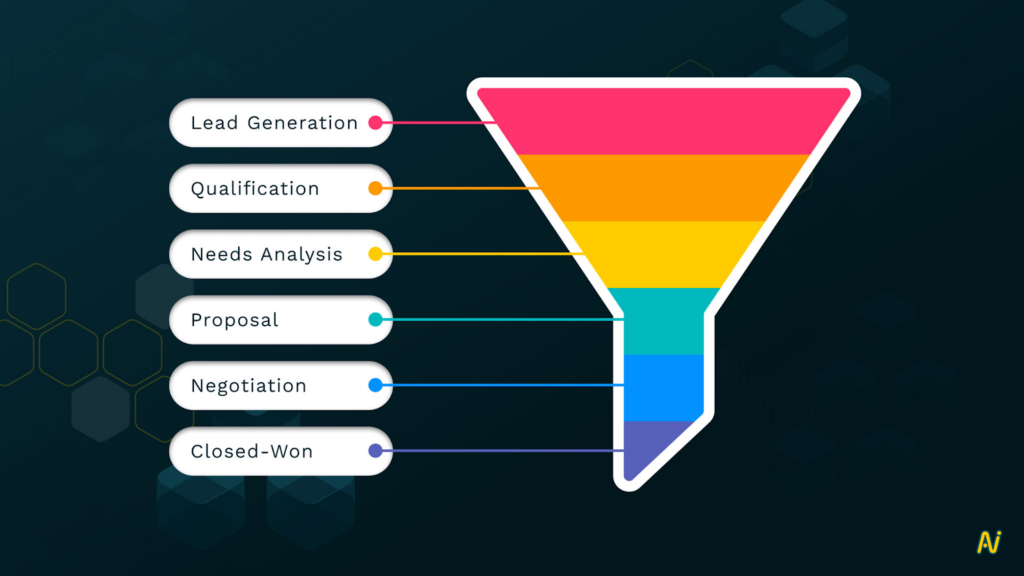In sales, every move counts, and every lead is a potential gem. To zero in on the correct opportunities, the sales team needs a guide.
Sales Pipeline coverage ratio can be that guiding light. In the age of sales analytics, understanding and mastering this powerful metric is like possessing a map of the hidden treasures of successful sales. The sales pipeline coverage ratio serves as a safeguarding model used by sales managers to gauge the company’s health and ensure that revenue objectives are achieved.
Let’s go through the sales pipeline coverage in detail. Let’s understand what it is. How does it affect the sales quota of personnel? What is the ideal pipeline-to-quota ratio? And what are some of the best practices and challenges of Sales Pipeline Coverage Ratio?

What is Sales Pipeline Coverage Ratio?
Sales pipeline coverage ratio is a measure of how well a sales team is converting leads into sales. It is calculated by dividing the number of sales made in a given period by the number of leads in the pipeline.
A high sales pipeline coverage ratio indicates that a sales team is converting leads into sales at a high rate. In contrast, a low sales pipeline coverage ratio indicates that a sales team is struggling to convert leads into sales.
A number of factors can affect a sales pipeline coverage ratio, such as the quality of the leads, the sales process, and the sales team’s experience. However, it is important to calculate the sales pipeline coverage ratio to get the actual picture of your pipeline.
The ratio provides a clear snapshot of your sales pipeline’s health and effectiveness. It offers insights into the quantity and quality of opportunities at various stages, enabling you to make informed decisions.

How to Calculate Your Sales Pipeline Coverage Ratio?
The Sales Pipeline Coverage Ratio can be calculated with this formula:

You can understand it like this:
When the average time for a sale to be finalized is 90 days, and the success rate of closing deals stands at 25%, the ratio between the pipeline and the sales quota becomes 4:1. This ratio signifies that to achieve the sales quota for a quarter, the total value of opportunities present in the pipeline should be four times the projected sales amount for that quarter.
Although certain teams continue to employ this formula for determining pipeline coverage, a growing number now utilize advanced sales software to derive a more accurate ratio. Contemporary sales execution platforms, for instance, swiftly collect sales analytics from every stage of the sales journey and procedure, subsequently computing pipeline coverage (along with other pertinent sales analytics metrics) automatically for a precision-driven and current evaluation.
Defining the optimal pipeline coverage ratio tailored to your business is advisable, as this aids your team in honing their computations. To understand the appropriate level of coverage required, it’s crucial to possess a solid understanding of the target benchmark you should be reaching at any specific point in time.
How Much Pipeline Coverage Should You Have?
Many sales experts recommend aiming for a sales pipeline-to-sales quota ratio of 3x or 4x. The majority of these recommendations are grounded in practicality. Is there an alternative method to precisely determine your sales pipeline coverage ratio?
Let’s explore an alternative perspective on pipeline coverage. The sales pipeline coverage ratio signifies the proportion between active pipelines and the number of sales quotas that must be fulfilled.
Given that not every potential sale will be successfully closed, it becomes imperative to have an adequate number of opportunities to achieve your sales targets. A coverage ratio of 1x wouldn’t suffice to meet your quota, as it would necessitate closing every single deal in your pipeline – an extremely challenging feat. Therefore, maintaining a pipeline-to-quota ratio of 3:1 or 4:1 is advisable as a general guideline.
However, to get the optimal number for your pipeline-to-quota ratio, you should consider the following factors:
1. Historical data and sales cycle
Examine your historical sales data to understand how long it takes for leads to move through your sales funnel and convert into customers. If your average sales cycle is longer, you might need a larger pipeline coverage to ensure a steady flow of deals.
2. Conversion rates
Evaluate your conversion rates at each stage of the sales process. If you have a high conversion rate from leads to opportunities but a lower rate from opportunities to closed deals, you might need a more extensive pipeline to compensate for potential drop-offs.
3. Market and industry factors
Consider the competitive landscape of your industry and market conditions. A higher pipeline coverage might provide a buffer against market fluctuations if your market is highly competitive and unpredictable.
4. Sales quotas and goals
Your sales quotas and revenue targets play a significant role in determining pipeline coverage. If your quotas are ambitious, you’ll likely need a larger pipeline to accommodate the necessary volume of opportunities.
5. Risk tolerance
Assess your company’s risk tolerance. If your business can’t afford a shortage of deals, you might lean towards a more conservative pipeline coverage to minimize the risk of missing targets.
6. Growth and expansion
If your business is in a growth phase or planning to expand into new markets, a higher pipeline coverage can support these endeavors by providing a cushion for unfamiliar territories.
7. Seasonality and trends
Consider any seasonality or cyclical trends that impact your industry. Adjust your pipeline coverage accordingly to accommodate fluctuations in demand.
The right amount of sales pipeline coverage strikes a balance between ensuring a consistent flow of potential deals and managing resources efficiently. It’s a dynamic metric that might need adjustment over time as your business evolves, market conditions change, and new opportunities arise.
How to Ensure a Healthy Sales Pipeline
A healthy sales pipeline encompasses a mix of early-stage prospects, active negotiations, and imminent closures. A healthy pipeline is characterized by consistent lead generation, effective lead qualification, and proactive deal management. Here are a few ways to ensure that your sales pipeline remains healthy:
1. Effective lead generation
Identify and target potential customers through various channels such as social media, networking events, and content marketing. Utilize lead magnets like ebooks, webinars, or free trials to capture leads’ contact information.
2. Qualification process
Implement a clear and comprehensive lead qualification process to focus on leads that have genuine potential to convert. Use criteria like budget, authority, need, and timeline (BANT) to prioritize leads.
3. CRM system
Utilize a Customer Relationship Management (CRM) system to manage and track leads, contacts, and interactions. This ensures timely follow-ups and prevents leads from falling through the cracks.
4. Segmentation
Categorize leads based on factors like industry, company size, or demographics. This allows for tailored communication and a more personalized sales approach.
4. Nurturing leads
Develop a lead nurturing strategy using content marketing, email campaigns, and personalized touchpoints. This keeps leads engaged and builds trust over time.
5. Demo and consultation
Offer product demonstrations or consultations to showcase the benefits of your solution. Address any questions or concerns your leads might have.
6. Feedback loop
Gather feedback from both successful and lost leads. Analyze why deals were won or lost to refine your approach and make necessary improvements.
7. Pipeline tracking and analysis
Monitor your sales pipeline’s health using metrics like conversion rates, lead velocity, and time to close. Regularly analyze these metrics to identify bottlenecks and areas for improvement.
Regular monitoring and refinement of the pipeline ensure a steady stream of revenue, accurate forecasting, and the agility to adapt to market changes. However, businesses also need to consider the challenges with the sales pipeline coverage ratio.
Challenges with Sales Pipeline Coverage Ratio
Even though the Sales Pipeline Coverage Ratio is an excellent indicator of your overall pipeline health, it comes with its own limitation:
1. Too many early-stage prospects
The consideration of stages in the opportunity process or the purchasing cycle is insufficient. For example, a comprehensive sales pipeline might include numerous early-stage prospects that are unlikely to close successfully. In such cases, having a high ratio of pipeline size to sales quota can lead to unwarranted confidence.
2. Focus on increasize sales pipeline than revenue
The number of potential leads in the pipeline increases due to optimism rather than genuine customer interest or interaction. The sales team feels pressure to increase the size of the pipeline because they are focused on achieving a specific pipeline-to-quota ratio.
3. No consideration for fallen deals
Similarly, deals that have previously fallen through and have low potential for successful resolution often fill up the pipeline. In each case, the pipeline becomes artificially enlarged.
4. Lack of consideration for all opportunities
The overall size of the pipeline doesn’t consider variations among different types of opportunities. For example, it’s reasonable to expect different win rates to be observed for new and existing clients, various business lines, and different geographic territories. Additionally, there might be potential opportunities in the pipeline that don’t currently exist. As a result, the pipeline coverage ratio serves as a metric that attempts to encompass all these factors.
Keep Track of Your Sales Pipeline Coverage Ratio
A mere 30% of organizations claim to possess the appropriate resources for leveraging data to enhance their strategies. Embracing a data-driven approach to pipeline coverage can become a genuine competitive advantage. To achieve this, sales leaders must collaborate to formulate plans and objectives that accurately reflect up-to-date pipeline coverage calculations.
Analyzing your pipeline coverage serves as a valuable diagnostic tool for assessing the well-being of both your sales pipeline and the associated processes. By tailoring and refining strategies according to your pipeline coverage, you can pinpoint effective practice areas needing improvement and proactively address potential issues with deals that are at risk of falling through.
In fact, employing suitable sales technology has the potential to gather and analyze precise, updated information automatically. This empowers sales and marketing teams to utilize their pipeline coverage ratio efficiently. Instead of expending time on manually extracting data, a task that often results in incomplete information without adequate tools, robust sales solutions ensure dependable, current outcomes and comprehensive visibility into the pipeline.
This is particularly crucial if your business encompasses multiple sales teams with distinct pipelines. Equipping your sales teams with the knowledge to pursue opportunities based on precisely computed pipeline coverage ratios and goals empowers them to channel their efforts toward the most valuable area.
For sales leaders to monitor the effectiveness of their sellers, they can gauge team members’ progress by considering aspects like pipeline quality, quantity, maturity, and coverage gaps. This necessitates a well-implemented Customer Relationship Management (CRM) system and a centralized sales execution platform that amalgamates transparency, real-time access, and current data into a single, user-friendly interface.
Enhance Sales Pipeline Visibility with Nektar
Utilizing Nektar, you have the capability to establish a scalable and repeatable sales process while gaining a comprehensive view of your sales pipeline. Nektar’s no-code solution collects data on revenue-related activities across various channels throughout the buyer’s journey, addressing gaps left by conventional solutions.
Having accurate and complete data in your CRM empowers your sales representatives to pinpoint and focus on ideal accounts, personalize communication, capture high-quality leads, automate sales procedures, and optimize opportunities for upselling and cross-selling.
With Nektar, you can:
- Easily monitor the number of untouched or inactive opportunities, ensuring that sales professionals prioritize strategic and high-value deals through timely follow-ups.
- Keep track of opportunities that lack robust engagement with multiple stakeholders, ensuring that your sales team consistently engages the entire buying committee.
- Identify genuine prospects sooner by monitoring the frequency of buyer-seller interactions.
- Quickly identify deals that are losing momentum as they remain stagnant in the same stage.
- Enhance forecast accuracy by proactively identifying opportunities likely to be delayed.
Nektar provides unparalleled visibility into your sales pipeline. To know more about our suite of products, contact us today!







